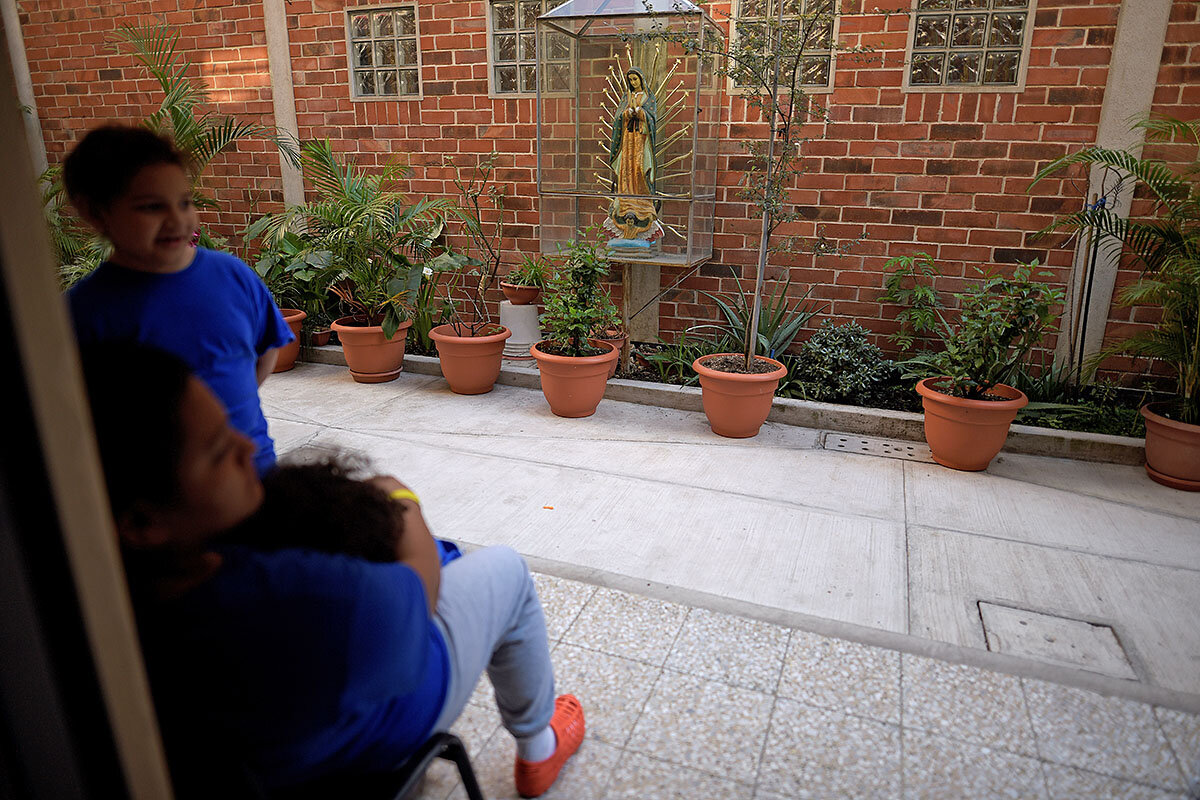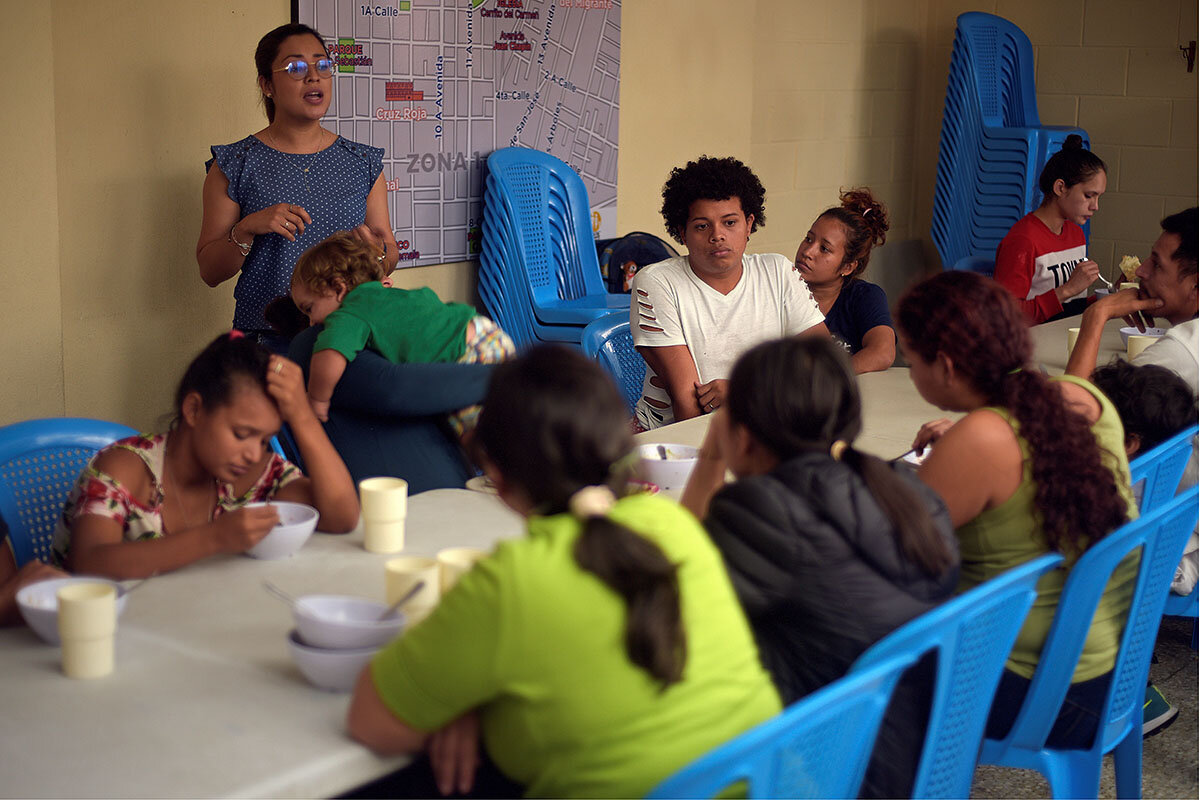2,000 miles, 72 hours, a tough choice: Asylum in Guatemala, or go home?
Loading...
| Guatemala City
Victor sits in a dimly lit hallway beside the small patio of the Casa del Migrante shelter, fidgeting with a plastic bag full of personal documents. It’s about 7:30 p.m. and he’s still trying to process the past 12 hours of his life.
Just this morning, he, his wife, and their two small boys were in the United States, hoping against hope to receive asylum from violence in their native Honduras. By the afternoon, they’d been loaded onto a plane filled with Guatemalan deportees and taken to Guatemala City, where U.S. officials said his family could request protection.
More than six months ago, he and his family fled Honduras where they faced extortion and violence. Now thousands of miles south of where he’d envisioned ending his journey in the U.S., Victor’s family has been given 72 hours to decide whether to apply for asylum here in Guatemala, or return home.
Why We Wrote This
Migration is a chain reaction – one the White House has tried to block, in part by sending asylum-seekers back to regions they fled. What awaits them there? Part 3 of 3 on the changing landscape of immigration.
Part 1: Meet the immigration attorney trying to serve 2,000 asylum-seekers
Part 2: Caught in the middle: How Mexico became Trump’s wall
“It felt like a trick,” he says of his interview with U.S. Customs and Border Protection agents after crossing illegally from Ciudad Juárez, Mexico, into El Paso, Texas. Victor’s last name has been omitted for safety, as it has for all migrants quoted in this article. “They asked if I was afraid to return to Honduras, but they wouldn’t let me tell them why. They asked if I would feel safe in Guatemala and I said no.” He had left Honduras after weekly payments demanded by local gangs started to exceed his income as a construction worker. A shakedown at gunpoint was his family’s final straw.
He says he needs to recover from the shock before he decides his next steps. A few things are certain: He won’t go home and he won’t stay here.
“That’s the thing,” Victor says, his voice falling to a whisper. “If Guatemala was safe, why was my plane full of Guatemalans wanting out in the first place?”
More of the migrants and refugees apprehended at the U.S. southern border come from Guatemala than from almost any other country: Some 18,000 Guatemalans have applied for asylum in the U.S. over the past two years alone.
Under a “safe third country” agreement signed by the U.S. and Guatemala last year, some Central Americans who travel to the U.S. to ask for asylum are now put on planes and required to apply in Guatemala first. It raises the question of whether Guatemala can meet the need, particularly as the number of potential asylum-seekers ramps up quickly in a country facing its own challenges with poverty and violence.
The Asylum Cooperative Agreement (ACA) has sent nearly 800 Hondurans and Salvadorans to Guatemala to date. It’s one of the many ways the Trump administration has transformed migration across the Americas, as the U.S. looks to shrink the tally of people entering at its southern border. The U.S. has put pressure on its southern neighbors to halt migration through threats of tariffs in Mexico; cutting development aid in Guatemala, El Salvador, and Honduras; and pressing leaders to sign safe third country agreements. El Salvador and Honduras are reportedly close to enacting similar plans with the U.S.
Guatemala’s asylum system is relatively young, and the process is cumbersome: The vice president and a handful of government ministers together make the final decision on each claim. Out of the hundreds of refugees sent to Guatemala from the U.S. via ACA, only 14 applied for asylum as of mid-February, according to Guatemala’s migration agency. It’s a reflection of how they view the proposition of seeking protection here, advocates say.
Sudden surge
When Guatemala launched its asylum system nearly two decades ago, it was without much fanfare. For the first decade, the annual number of people seeking refuge in Guatemala barely reached double digits – and the number of cases accepted hovered around two to three, sometimes zero. By 2014, when a surge in unaccompanied minors leaving the region for the U.S. made its way across the region, those numbers shot up: One hundred people applied for protection in Guatemala, with 17 cases approved. In 2016, nearly 150 people applied and a record 74 cases were approved. In total, just shy of 315 people received asylum here between 2002 and November 2019, according to government statistics. Nearly 600 are still awaiting responses to their cases.
But those numbers are nominal compared with neighboring Mexico, where sought refugee status in 2019. The U.S., meanwhile, had nearly 93,000 people on the southwest border express fear of returning home in fiscal year 2018. And while a handful of refugees – from Belize, China, and Venezuela – have found protection in Guatemala since 2002, were apprehended at the U.S. southern border last year alone.
Guatemala isn’t an appropriate place to send asylum-seekers, says Rick Jones, a senior adviser in Latin America for Catholic Relief Services. “They have trouble protecting their own people at risk, let alone people from third countries,” he says. Under Guatemala’s last administration, state funding was cut for the few shelters, like Casa del Migrante, that serve asylum-seekers, migrants, and deportees.
“Few are seeking asylum here,” says the Rev. Mauro Verzeletti, director of Casa del Migrante, which houses about 50 people daily and receives ACA arrivals. “It’s a game of cat and mouse. Hondurans and Salvadorans know the situation in Guatemala. Many are returning to Mexico or trying again in the U.S. There’s nothing for them here. There’s nothing for them in their own countries. If your life was at risk, what would you do?”
“The state doesn’t have the capacity to address these situations.”
The United Nations has provided support to the Guatemalan government since its asylum program’s inception, and that involvement has increased since the number of people seeking international protection shot up around 2017. It’s now focused on helping Guatemalan authorities modernize, expand, and streamline the system.
“It’s not as strange as one might think,” to offer asylum in a country where there are large numbers of people leaving to seek protection elsewhere, says Rebecca Cenalmor-Rejas, the head of The U.N. Refugee Agency (UNHCR) in Guatemala. Ms. Cenalmor-Rejas cites examples like Colombia, which has one of the world’s highest numbers of people displaced within their own country, but has also taken in of Venezuelans since 2014.
“Guatemala has a nascent asylum system with some limitations, and many opportunities for improvement,” she says.
The Trump administration says ACA helps drive down the number of migrants asking for asylum in the U.S. and that Guatemala is a safe place for migrants to seek protection.
Guatemala’s central migration office is a tall, Brutalist-style building, with a steady stream of visitors walking through a metal detector at the front door. In a shared office beyond the posters warning about child trafficking, as well as the residual Christmas decor still hanging from the ceiling, a spokeswoman for Guatemala’s migration agency, Alejandra Mena, prints off pages of asylum statistics.
“There’s no limit on how many requests for asylum we’ll take,” Ms. Mena says. “But the U.S. has respected the number of people we can manage right now.” Some 789 people via ACA as of March 3, and she says they are given the option to apply for asylum or return to their home country.
“A recognized refugee has all the rights – and obligations – of a Guatemalan citizen,” Ms. Mena says, including access to hospitals, education, public services, and employment.
Search for stability
That guarantee has proved complicated for people like 19-year-old Jonathan, a refugee who arrived from Honduras almost two years ago. He sits on the sunny second floor of the Raíces de Amor shelter for migrant and refugee minors on a recent morning, recounting how Guatemala was never part of his plan.
He came from a life of crime and drug use in coastal Honduras, he says. After fleeing violence at home – some of which he participated in – he fell in with some “bad characters” on the Mexico-Guatemala border, he says, who convinced him to help rob migrants heading toward the U.S. They promised to help feed his drug addiction.
“When you’re young, you don’t think things through,” he says of his 17-year-old self. “I got into trouble; I suffered. I wasn’t a great person.”
Since arriving at the shelter, he’s studied and had access to a social worker and medical attention. He says he’s a new person and now dreams of going to college to study psychology.
Refugee status granted, he moved out of the shelter last July, with high hopes of finding work and saving up for school. But he’s hit a dead end. Although being a refugee entitles him to all the rights of a Guatemalan national, he can’t get formal work, buy a phone, or open a bank account because he doesn’t have a national identification card. That would require a mountain of paperwork and fees that he estimates would cost him roughly $200.
“If it weren’t for this shelter, I’d be dead in the street by now,” he says, before going downstairs for lunch.
He’s tried picking up odd jobs at bodegas and other shops in his neighborhood, presenting his résumé and paperwork recognizing he’s in Guatemala legally. But “they ask where I’m from and the conversation stops. ‘Oh, I can’t hire a Honduran.’ It’s so upsetting,” he says. “There’s something inside me I want to give the world, and I kept being told no.”
Overall, the teens here are grateful for the protection that Guatemala – and this shelter – has provided them. But their stories underscore the shortcomings of Guatemala’s social welfare system and the asylum system in its current state.
Another young woman here, Blanca, fled gang threats in Honduras two years ago with no destination in mind. After arriving in Guatemala, the pregnant teen was nearly taken by human traffickers. When she went to the police she was placed in a “safe home” for troubled children – institutions known for widespread abuse and worse – for more than a year. She was almost deported back to Honduras without hearing about the possibility of asylum. A sympathetic judge, who said he wouldn’t deport her because of her Guatemalan-born son, sent her case to El Refugio de la Niñez, which launched a program for minors seeking refuge in 2016. It helped her prepare paperwork for asylum, provided therapy, and encouraged her to start thinking about a future again. Through the organization, which receives funding from the UNHCR, she’s been able to study and take job-training courses.
“I have more opportunity here in Guatemala,” she says, acknowledging that few people in Honduras dream of seeking opportunity in the country next door.
There are about 10 youth with similar stories at the Raíces de Amor shelter right now. Staff members say many Guatemalans question how they – or the government – can be giving resources to youth from other troubled nations when so many children here are already at risk. There are in state and privately run homes here, in a country of 17 million.
“We can work with this number of asylum-seekers and maybe a little more,” says Karen Revolorio, spokeswoman for El Refugio de la Niñez, which runs a network of shelters, including this one. But that’s because of outside support like the UNHCR, she says. If a higher proportion of people arriving via ACA start seeking asylum in Guatemala, she’s “not sure [they’ll] see the same results as these teens.”
Back at Casa del Migrante, it’s almost time for lights out. Toddlers and small children are herded upstairs one by one to brush their teeth and snuggle into their dorms with their shellshocked mothers and fathers.
People arriving through ACA are “paranoid, distressed; they don’t know if it’s day or night. They’ve all been in detention and they arrive here without information,” says Mr. Verzeletti, the priest. “It’s a form of torture.”
And despite efforts by the U.S. to deter migrants via “the wall, ‘Remain in Mexico,’ and ACA, this flow of migration won’t stop,” he says.
It’s something that, despite the suffering, actually gives him hope.
“Migration is hope. People, just by moving, that’s a sign that they have hope” for their futures, somewhere, Mr. Verzeletti says.






